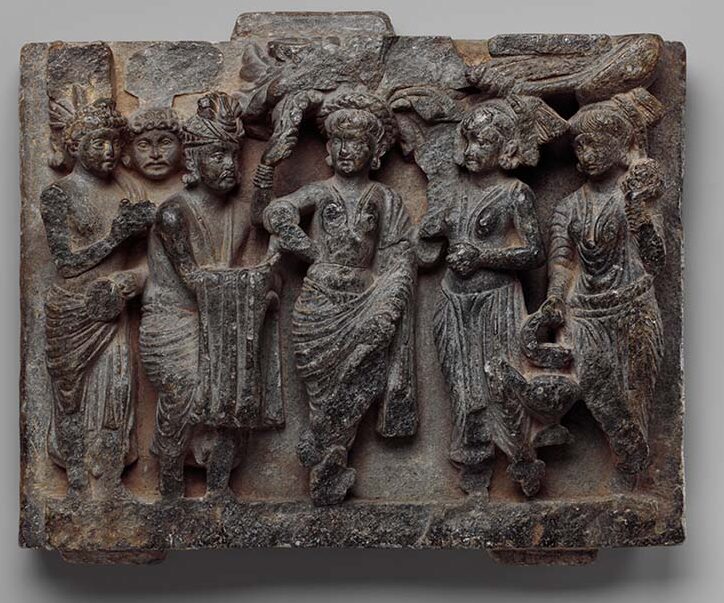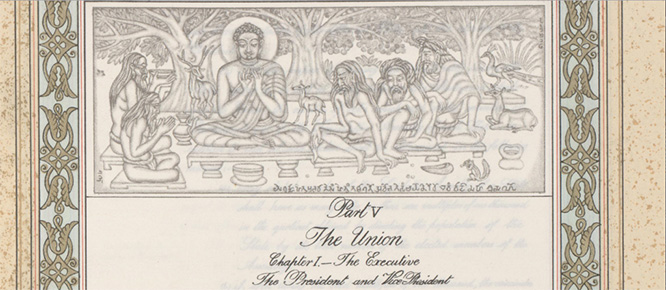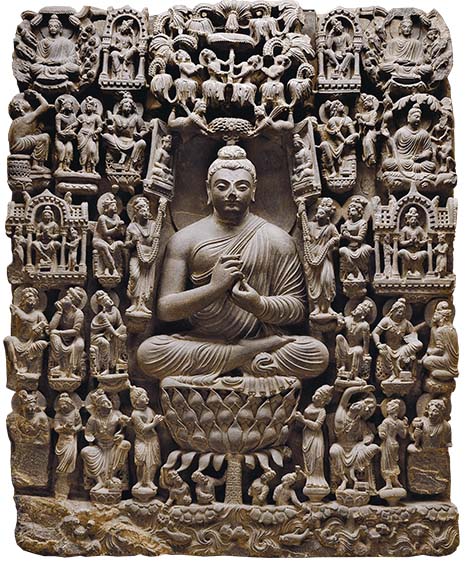India is the land of the Buddha, of the Dhamma and of the Sangha.
Join Cultural Samvaad’s WhatsApp community
Gautama Buddha, the Buddha of our times who was one of the greatest Chakravartis ever born in this world. He lived and roamed in the spiritually fertile land of India during the 5th-6th centuries BCE. A mahapurusha and a spiritual leader of human beings, he is considered as the founder of Buddhism, a world religion and an avatar of Vishnu in Hinduism.
Shakyamuni Buddha was a prolific preacher and his words or Buddhavachana reverberate even 2,500 years after they were first received. The Dhamma that he preached travelled over land and over oceans and seas to many countries through the centuries.
Given the impact that he had had on the realm of human beings, it is but natural that the story of the Buddha’s life and the narrations of the many miracles that he is said to have performed, have multiple tellings in tradition and in arts and literature. Even though the Buddha was a historical figure, his biography can be characterised as an inspirational hagiography and draws from multiple sources including the Sutta and Vinaya Pitakas and texts such as the Lalitavistara, Mahavastu, Buddhacharita and Nidanakatha.
Most tellings of the story of Buddha refer in some form to the most important events in his life:
- Birth at Lumbini;
- Maha abhinishkramana or renunciation and going forth at Kapilavastu;
- Enlightenment or awakening at Bodhgaya;
- First sermon or Dharmachakra pravartana at Sarnath and;
- Maha parinirvana at Kushinagara.
Lumbini (now in Nepal); Bodhgaya (now in Bihar, India); Sarnath (next to present day Varanasi in Uttar Pradesh, India) and Kushinagar (now in Uttar Pradesh, India) are also the four most important pilgrimage sites for Buddhists across the world.
The full moon day in the month of Vaishakha is universally celebrated as Buddha Purnima (Vesak Day) to mark three critical milestones of his life – birth, awakening and maha parinirvana or passing away from being.
The Story of Gautam Buddha
The story of Gautam Buddha’s life begins many aeons ago, in the era of Dipankara Buddha (there are different Buddhas in different times as per tradition). In that auspicious era, there lived a pious hermit called Sumedha who performed pious acts. On witnessing those untold acts of piety, Dipankara Buddha predicted that Sumedha would become the Shakyamuni Buddha in the future, the Buddha of our times.
Buddha’s Birth and Early Life
As per tradition when Siddhartha (the one who achieves his goals) was conceived, Queen Maya Devi, his mother dreamt that a 6-tusked white elephant entered her womb. She and King Suddhodana, the Shakyan ruler of Kapilavastu were overjoyed at this auspicious vision.

Siddhartha emerged from his mother’s side in a heavenly grove in Lumbini. Born with the 32 auspicious signs of a mahapurusha or a great man, he was received by Shakra or Indra, the Lord of the Devas. His mother passed away a few days later.
यस्य प्रसूतौ गिरिराजकीला वाताहता नौरिव भूश्चचाल ।
सचन्दना चोत्पलपद्मगर्भा पपात वृष्टिर्गगनादनभ्रात् ॥
वाता ववुः स्पर्शसुखा मनोज्ञा दिव्यानि वासांस्यवपातयन्तः ।
सूर्यः स एवाभ्यधिकं चकाशे जज्वाल सौम्याचिरनीरितोऽग्निः ॥
When Gautama Buddha was born, the earth, even though it was fastened to the Himalayas (the king of mountains), trembled with joy and excitement like a ship driven by the winds. Showers scented with sandalwood and resplendent with blue and pink lotuses fell from the cloudy skies. Enchanting, soft winds engulfed the earth and showered heavenly dresses. The sun shone most brightly and fire, though unstirred, blazed with beautiful flames.
Buddhacharitam – Ashvaghosha – 1.21 & 1.22
Gautama was brought up by his foster mother – Mahaprajapati Gautami who also became his first woman disciple and founded the order of the nuns or bhikunnis. The wise foretold that the child would grow up to become a Chakravarti – either a great king or a great spiritual leader and renouncer. His father Suddhodana wanted his son to become a king and is said to have left no stone unturned to change his eventual destiny by ensuring that he lived a sheltered life filled with royal comforts and pleasures.
As a young boy, Siddhartha was precocious and meditative. He excelled in academic and non-academic pursuits was a skilled warrior and a true kshatriya.
When he grew up, Siddhartha Gautama was married to the beautiful princess Yashodhara and their only child was named Rahula.
Buddha’s Renunciation and Quest for Enlightenment
At the age of 29, Siddhartha is believed to have seen four great sights – an old man, a sick man, a dead man and a wandering ascetic. Moved beyond words and having realised the impermanence of all worldly pleasures, he decided to renounce everything including his family.
Dr. S. Radhakrishnan describes these momentous sights and their transformational impact on Gautama Buddha in the following words. “On four occasions when he went out of his palace, so the legend tells us, he met an old man and felt that he was subject to the frailties of age, met a sick man and felt that he was liable to sickness, met a corpse and felt that he was also subject to death, and met an ascetic with a peaceful countenance who had adopted the traditional way of the seekers of religious truth. The sight of the holy man, healthy in body, cheerful in mind, without any of the comforts of life, impressed the Buddha strongly with the conviction that the pursuit of religion was the only goal worthy of man. It makes man independent of the temporary trials and fleeting pleasures of the world. The Buddha resolved to gain freedom from old age, sickness and death by following his example.”

In the middle of one auspicious night, a transformed Siddhartha summoned his charioteer Chandaka and his favourite horse Kanthaka to escort him outside the precincts of his palace and his town. He unshackled himself from all material ties and belongings and went forth as an ascetic or a shramana.
For the next few years, Gautam wandered in search of true knowledge. He learnt meditation from the great masters of the day and practised severe austerities but was not satisfied. It is believed that his untold austerities brought him as close to death as can be imagined. A young lady (generally referred to as Sujata) offered him milk and rice which rejuvenated him and he embarked on his final quest for awakening.
Buddha’s Awakening
The time for enlightenment had come. Siddhartha who had resolved that that was his last birth, sat under a pipal tree in deep meditation while Mara, the chief divinity in the realm of desires, unleashed a multi-pronged assault on him to prevent his enlightenment.
Gautama defeated Mara and his temptations. He touched the earth (depicted in the arts as bhumisparsha mudra or earth-touching gesture) beckoning her to be his witness and went into a meditative trance.

Gautama became the Buddha or the Awakened One during the night following the defeat of Mara when he was sitting under the sacred pipal tree in Bodhgaya. He was only 35.
स सुवर्णपीनयुगबाहुर्ऋषभगतिरायतेक्षणः ।
प्लक्षमवनिरुहमभ्यगमत्परमस्य निश्चयविधेर्बुभुत्सया ||
उपविश्य तत्र कृतबुद्धिरचलधृतिरद्रिराजवत् ।
मारबलमजयदुग्रमथो बुबुधे पदं शिवमहार्यमव्ययं ||
He (Gautam Buddha) who had long and golden arms, walked like a bull and had piercing, large eyes; went near a pipal tree in search of the best path of fulfilling his unparalleled quest. He sat there in a determined manner. As immovable and steady as the Himalayas (the king of mountains), he defeated the furious army of Mara. And then, he came to understand that which is auspicious, imperishable and eternal (became enlightened or awakened).
Saundaranada Kavya – Ashvaghosha – 3.6 & 3.7
The Great Mahabodhi Temple at Bodhgaya (a UNESCO World Heritage Site) is supposed to have been constructed at the same site where Gautama Buddha attained enlightenment.
Buddha’s First Sermon – The Turning of the Wheel
In most traditional accounts, Buddha stayed in the vicinity of Bodhgaya for the next seven weeks meditating on his awakening and the Truth that he had realised. At the end of the seven weeks, Brahma implored the Buddha to teach the Dharma or Dhamma to others.
Buddha went to Sarnath (present day Varanasi) where he delivered his first sermon (commonly referred to as the Dhammacakkappavattana Sutta), to five disciples who were also his companions earlier.
The Wheel of Dharma turned. In his first discourse, Buddha expounded the arya-ashtanga-marga or the Middle Way and the chatvari aryasatyani (चत्वारि आर्यसत्यानि) or the Four Noble Truths or Realities. As per tradition, one of the five disciples Kondanna is said to have understood the Four Noble Truths instantaneously and attained nibbana or nirvana at the end of the sermon.
This epoch-making event is also depicted in an illustration in the original manuscript of the Constitution of India.

Buddha’s Miracles and Preaching of the Dhamma
Buddha wandered from place to place and preached for almost 45 years after his awakening and halted only during the monsoons (rain retreat or varsha vasa). He is also said to have performed many miracles in his life.
It is believed that he spent almost 19 rainy seasons at Jetavana in Shravasti, an important Buddhist pilgrimage site. This is also the place where he is said to have performed the famous Shravasti Miracle which is widely depicted in art. The Buddha defeated other famous teachers of his times and created multiple replicas of himself. Flames emerged from his upper torso while streams of water fell from his feet.

The Buddha is said to have gone to the Trayastrimsa Heaven to teach the dhamma to his mother Mahamaya during one rain retreat and then ascended from the heaven at Sankissa.
The Buddha was revered even by animals and birds. In a famous story that is often depicted in arts and sculpture, a monkey is said to have offered him honey or madhu which he accepted gracefully.
Buddha’s Mahaparinirvana
The Buddha’s final year in which he was unwell is described in some detail in the Mahāparinibbānasutta in the Pali tradition and its parallels in other canonical traditions.
His last meal at Cunda, the smith’s house in Pava is said to have included a dish referred to as ‘pig’s delight’ (सूकरमद्दव). Whether or not the meal consisted of pork or was made of mushrooms is a matter of scholarly debate.
Shakyamuni Buddha attained maha parinirvana at the age of 80 in Kushinagara. The Buddha was no more. The Tathagata was completely extinguished. His mortal remains were cremated by his grief-stricken followers in a befitting manner.
A war is said to have broken out over the custody of the Buddha’s relics among his followers who came from the many kingdoms where he was revered.
Drona, a learned Brahmin is said to have acted as an arbitrator. He distributed the relics into 8 parts and eight stupas were erected at important sites on his relics by King Ajatasatru of Magadha, the Licchavis of Vaishali, the Sakyans of Kapilavastu, the Bulis of Allakappa, the Koḷiyans of Ramagrama, the brahmin of Veṭhadipa, the Mallas of Pava and the Mallas of Kusinagara.
Drona himself received the urn in which the relics had been collected whereas the Moriyas of Pippalivana received the embers. 2 additional stupas are said to have been erected on the urn and the embers.
सब्बेव भोन्तो सहिता समग्गा,
सम्मोदमाना करोमट्ठभागे;
वित्थारिका होन्तु दिसासु थूपा,
बहू जना चक्खुमतो पसन्ना ति।
Let us make eight portions, good sirs,
rejoicing in unity and harmony;
Let there be monuments far and wide,
so many folk may gain faith in the Seer (Buddha).
Digha Nikaya – 16 – Mahāparinibbānasutta

The Mauryan King Ashoka is said to have re-excavated these relics and further distributed them to erect 84,000 stupas. These stupas have played a pivotal role in the history of the Indian subcontinent and Buddhism.
Buddha’s Teachings – His Dhamma
The Tathagata attained parinirvana but the sangha that he established and the Dhamma that he preached in the people’s own language travelled across land and across seas to many other countries. While the Buddha in all likelihood did not believe that he was establishing a new and independent religion, Buddhism developed as an independent faith over the centuries. Many schools of Buddhism came into being as the Buddha’s teachings got assimilated into and transformed by different cultures and commented on by great scholars and monks.
The chatvari aryasatyani or the Four Noble Truths or Realities that Shakyamuni Buddha expounded during the Dharmachakrapravartana (the Turning of the Wheel) at Sarnath, form the foundation of his teachings. The four true realities are:
- The existence of Dukkha or pain or suffering in its various forms in the world.
- The origination of suffering and pain or Dukkha Samudaya primarily attributed to craving (craving for sensual pleasures, craving to continue existence and craving to end existence) or trishna (कामतण्हा, भवतण्हा, विभवतण्हा) and related causes.
- The cessation of suffering and pain or Dukkha Nirodha.
- The eight-fold middle path or the Aryaashtangika Marga (आर्याष्टाङ्गमार्ग) that leads to the cessation of dukkha. Right View, Right Resolve or Intention, Right Speech, Right Action, Right Livelihood, Right Effort, Right Mindfulness and Right Concentration or Samadhi together constitute the Noble Middle Path.
If one can realise and penetrate the four true realities, one can cut off the craving for existence, destroy that which leads to this cycle of birth, death and rebirth and ensure that there is no fresh becoming. One can attain nirvana.
Gautama Buddha’s eternal message of exhorting human beings to become lights unto themselves is a clarion call for the establishment of a new global order and is a timeless inspiration for one and all. The Dhamma that he expounded continues to hold sway millennia after he roamed the earth and inspires Indians and his followers across the globe to become lights unto themselves.
अत्तदीपा, भिक्खवे, विहरथ अत्तसरणा अनञ्ञसरणा, धम्मदीपा धम्मसरणा अनञ्ञसरणा।
Bhikkhus (Mendicants), live as your own light, your own refuge, with no other refuge. Let the teaching be your light and your refuge, with no other refuge.
Digha Nikaya – 26 – Cakkavatisutta


Very informative